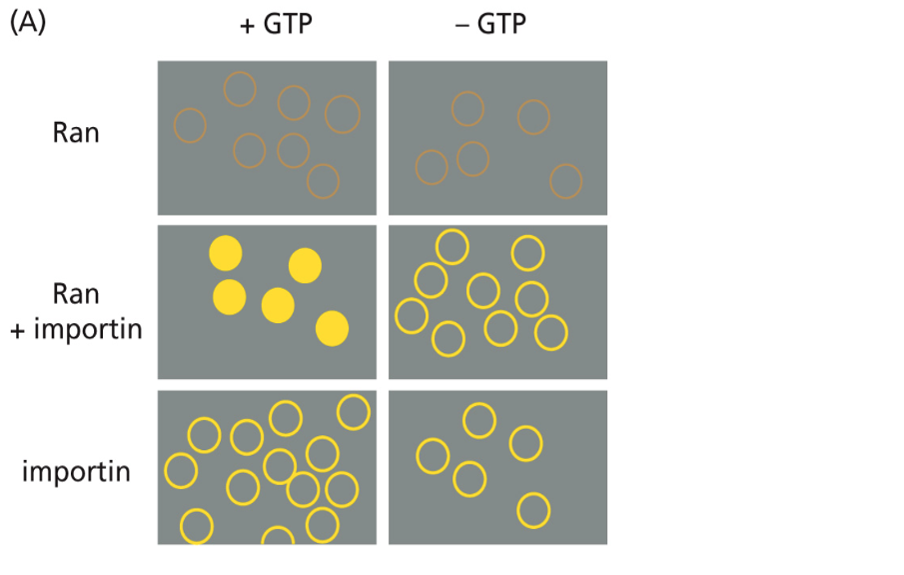
Concept explainers
The following image is based on real results from an influential experiment in cell biology. This experiment studied the role of the proteins Ran and importin in nuclear protein transport. The experiment used flourescently-labeled proteins containing a nuclear localization sequence (the "substrate"). Ran, importin, and GTP were either present or absent, as indicated in the figure. Cells were exposed to these different conditions and then analyzed by fluorescence microscopy.
Circles are the cells' nuclei. Very light circles are the nuclei without the substrate attached.
Study the figure below and then answer the questions that follow.
1. What actions does Ran perform by itself?
2. What actions does importin perform by itself?
3. How do Ran and importin act together in the nuclear import of protein?
4. Why is GTP required?

Trending nowThis is a popular solution!
Step by stepSolved in 2 steps

- Consider the amino acids on the image below. Which of the following amino acids would be most likely to be found in the part of an integral membrane protein that is located within the membrane? (Select all answers that apply.) Asparagine (Asn) Lysine (Lys) Phenylalanine (Phe) Valine (Val) Glutamic acid (Glu) Methionine (Met)arrow_forwardWhat would most likely occur to nuclear-cytoplasmic shuttling if the intrinsic GTPase activity of RAN was slowed down by 50%? Group of answer choices RAN would not bind exportin and proteins would accumulate in the nucleus All of the answers are likely None of the answers are likely Importin beta would not release from RAN in the cytoplasm and nuclear import would slow down RAN would not bind to importin beta and protein cargo in the nucleus would not releasearrow_forwardExplain what the Holliday Model is describing what type of event in a cell? Explain three key features of the improved Holliday Model and its resolution.arrow_forward
- In the absence of tension, MscL channel has an energy gap separating the closed and open states Eo = 50 kT. MscL opening is associated with a 20 nm2 in-plane protein expansion (change in A). Plot its open probability (Po) as a function of membrane tension. What will be the open probabilities of two MscL channels if one situates at the pole of the bacterial cell above, another in the middle?arrow_forwardWhat type of signal sequence(s) would be used to create the ACE2 (type 1) integral membrane protein?arrow_forwardIf you did a classic Pulse-Chase experiment to follow the path of a secreted protein, and you forgot to do the Chase, which of the following would you observe? No radioactivity would be seen in any of the structures. Radioactivity would increase first in rough ER, then Golgi Complex, then secretory vesicles, but it would remain high in all, never decreasing. Nothing would change Radioactivity would increase in all 3 structures simultaneously and stay high.arrow_forward
- Ran is a major player in the process of nucleocytoplasmic transport via the nuclear pore. Because net Ran movement simply follows a concentration gradient, what maintains the Ran gradient across the nuclear membrane? Options: the concentration levels of cargo in the nucleus to be exported GTP concentrations in the nucleus the correct positioning of the GEF and GAP with respect to the nuclear envelope the interaction of exportin and importin with their cognate substrates none of the abovearrow_forwardDetermine how many domains and list the residues in each domains (ei. 1-230, 1-120) Vertebrate Ca 2+ -dependent cell adhesion protein (4VCA): Proteobacterial DNA topoisomerase subunit (5PDT): Vertebrate cell receptor (6VCR)arrow_forwardWhy is the structure of the plasma membrane considered to be a fluid-mosaic model?arrow_forward
 Human Anatomy & Physiology (11th Edition)BiologyISBN:9780134580999Author:Elaine N. Marieb, Katja N. HoehnPublisher:PEARSON
Human Anatomy & Physiology (11th Edition)BiologyISBN:9780134580999Author:Elaine N. Marieb, Katja N. HoehnPublisher:PEARSON Biology 2eBiologyISBN:9781947172517Author:Matthew Douglas, Jung Choi, Mary Ann ClarkPublisher:OpenStax
Biology 2eBiologyISBN:9781947172517Author:Matthew Douglas, Jung Choi, Mary Ann ClarkPublisher:OpenStax Anatomy & PhysiologyBiologyISBN:9781259398629Author:McKinley, Michael P., O'loughlin, Valerie Dean, Bidle, Theresa StouterPublisher:Mcgraw Hill Education,
Anatomy & PhysiologyBiologyISBN:9781259398629Author:McKinley, Michael P., O'loughlin, Valerie Dean, Bidle, Theresa StouterPublisher:Mcgraw Hill Education, Molecular Biology of the Cell (Sixth Edition)BiologyISBN:9780815344322Author:Bruce Alberts, Alexander D. Johnson, Julian Lewis, David Morgan, Martin Raff, Keith Roberts, Peter WalterPublisher:W. W. Norton & Company
Molecular Biology of the Cell (Sixth Edition)BiologyISBN:9780815344322Author:Bruce Alberts, Alexander D. Johnson, Julian Lewis, David Morgan, Martin Raff, Keith Roberts, Peter WalterPublisher:W. W. Norton & Company Laboratory Manual For Human Anatomy & PhysiologyBiologyISBN:9781260159363Author:Martin, Terry R., Prentice-craver, CynthiaPublisher:McGraw-Hill Publishing Co.
Laboratory Manual For Human Anatomy & PhysiologyBiologyISBN:9781260159363Author:Martin, Terry R., Prentice-craver, CynthiaPublisher:McGraw-Hill Publishing Co. Inquiry Into Life (16th Edition)BiologyISBN:9781260231700Author:Sylvia S. Mader, Michael WindelspechtPublisher:McGraw Hill Education
Inquiry Into Life (16th Edition)BiologyISBN:9781260231700Author:Sylvia S. Mader, Michael WindelspechtPublisher:McGraw Hill Education





